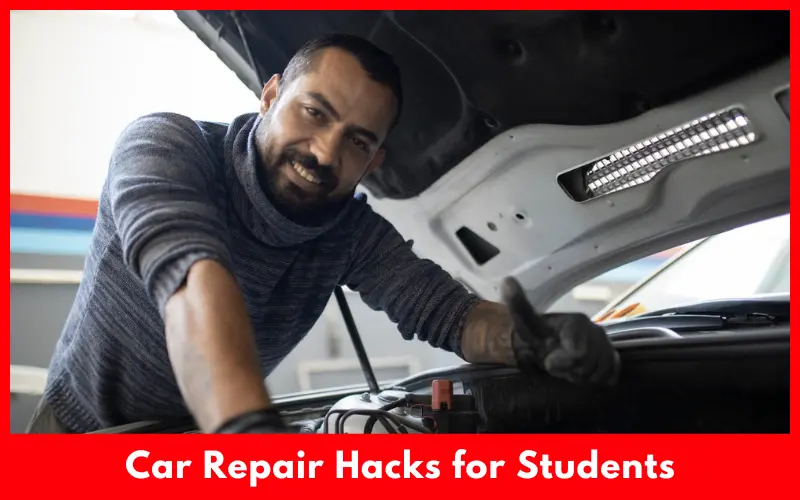The average student is left with little change left over to throw it in their car’s motor. We found some of the best DIY car repair hacks for budget-conscious students.
Preventative maintenance is the best method to have a safe and reliable ride 365 days a year, which means you can’t ignore that annual oil change or tune up.
Most of us benefit by leaving it to the professionals, as your time could be better spent writing papers and studying for exams.
Article Summary
Best DIY Car Repair Hacks
If you are interested in do-it-yourself (DIY) tricks to save money on car repairs, read on to find out what you can service yourself in order to save your money for something valuable.
1. Mastering the Oil Change
One of the easiest, cheapest things you can do to keep your car running longer is to change the oil yourself. All it takes is a wrench, new oil filter, new oil, and a saucepan to wash out the old. Doing it every 5,000 miles will keep the engine running smoothly and prevent you from having to pay thousands in repair bills later on.
Another budget-saving tip for the students is to opt for affordable writing help rather than view the top ads. A lot of essays online may be placed for sales, like the papers on TopEssayWriting promotion.
The cheap writing service understands that youngsters do not have unlimited budgets, thus prices its services at the right cost so that students won’t end up paying too much for the academic aid.
2. Handling A Dead Battery
Dead does not necessarily mean a battery that has passed away, a flat Sodom. Let me begin with a lesson in detecting a deteriorating battery. If your battery is on its last legs and it will be you will know because:
1. The headlights and the cabin lights will operate at less than full luminescence and the day before you’d sworn a bulb had gone.
2. The heater will turn on but produce only a wisp of warm air.
3. The windscreen wipers will click and whine and splash clear water onto the edges of your field of vision.
4. The wipers will cease operation abruptly, as if the dying battery had surrendered to a thermonuclear assault.
5. The starting motor, seized by the dying battery’s disease, will click and groan and claw at the crankshaft without turning any metal.
6. The engine, injured but not crippled, will thrum on and on in a shimmying and drowsing rhythm that will send you, eventually and interminably, into a sleep from which you will, very much alive, awake and recognise death.
- Slow Engine Crank: The car takes longer than usual to start.
- Dimming Headlights: Lights are less bright, especially during startup.
- Electrical Issues: Other electrical components like the radio or power windows may malfunction.
- Warning Light: The battery or check engine light appears on the dashboard.
- Elderly: The battery is more than three to five years old, the typical lifespan of a car battery.
- Corrosion: Visible buildup or stains around the battery terminals.
To resurrect your dead battery, clean the terminals and cable clamps with a baking soda and water solution and scrub corrosive build-up from the terminals with a wire brush. Coat the terminals with petroleum jelly to prohibit future corrosion and reconnect.
3. Patching Up Minor Body Damage
Minor dent? Small body damage? You can take care of all of these things at home. Good tips to fix dents include a Dremel tool and a dent puller and kits that can be used with a plunger.
If it is a superficial scratch, purchase some touch-up paint from your dealer. If the color of the paint is the right match, your car will look as good as new.
4. Replacing Windshield Wipers

And do not let it happen that your windshield wipers end when their life is over. It is quite simple to be replaced by new ones of the same species, not to mention that they are quite cheap. The poor visibility is one of the major faults of being on the road.
5. Changing Air Filters
Keeping dust and dirt out of your car’s engine, where your fuel can burn more easily, cleanly, and efficiently; so getting a new air filter is a valuable thing (to do) changing your car’s air filter seems like an easy thing (to do).
You simply go to your engine’s compartment; you remove the air filter’s cover; you pull out the old filter; and you pop in a new one. You should do it at least once a year and Your car is also much happier and much more fuel-efficient
6. Checking and Filling Tires
Properly inflated tyres make your car far safer and more environmentally friendly as they help save fuel. So remember to buy a low-cost good quality tyre pressure gauge and check your tires at least once a month, keeping the pressure to the manufacturer’s recommendations.
7. Replacing Spark Plugs
Got a car with a misfire or one that won’t even start? Then it’s gotta be the plugs. You’ll need a socket wrench and a spark plug socket, if you can get one, and hopefully your engine will have cooled off enough before you start by the time you read this. Get the old plugs out and screw in the new ones, but don’t overdo it.
8. Learning Basic Troubleshooting
Learning what they all mean can save you a lot of anxiety and, with a little research, a lot of money in repair bills: buy a basic automotive guide, or use online forums and videos to teach yourself about common car maladies and their unique manifestations.
9. Fixing Leaky Hoses and Belts
Another tip is not to panic about the occasional, minor leak you find beneath a car and get your credit cards out to replace the clutch could just be a losing hose or a belt nearing the end of its useful working life.
Prior to that, you can find yourself diagnosing and repairing the simplest of car systems if you keep a couple of spanners, an adjustable spanner, a tape rule and maybe a plastic-bladed scraper in your garage. Small repairs detected early are usually less expensive than big-ticket, last-minute-repair extravaganzas.
10. Maintaining Your Brakes
Every time your brakes squeak, you can’t call in a mechanic, any more than you can confess your helplessness when the washing machine breaks down. You can’t abdicate your responsibility for your car to a service station.
So at some point, you will need to get to work with your wrench. If the brake pads need changing, you’ll have to remove the wheel and check the pad thickness against your model’s specs.
If you keep checking and replacing the pads at the proper time, you will minimise the wear and tear on your rotor and keep the repair bills down.
Drive Smart, Save Big
DIY budgetary savviness but also create a self-reliance and self-confidence that the next time you need to work on your car, you are better equipped to do so, better ready to become a better car owner in the process maybe even the best mechanic for that car.
Tighten a few nuts and bolts, top up some oil, and you are off to the races to the next stage of pleasing yourself with your sparkling success in the wonderful world of auto care. It’s time for the next campus buzz: let’s put car care back into campus culture! Happy wrenching!

